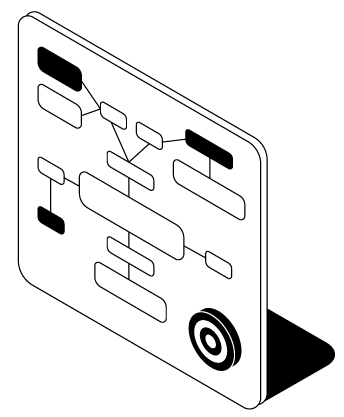BLOG | November 21, 2023
DTCx Talks: Lesson 2 of 4 - 8 Tips to improve your customer experience
By Amanda Kwasniewicz and Winclap
Disclaimer:
This article is based on Amanda Kwasniewicz’s recent presentation: “Elevating Customer Experience and Operational Excellence in Wellness Marketing” at the DTCx Talks event in NY. It’s not an official transcript or endorsement of her work.
The information in this article is intended for educational purposes only.
Lesson 2: Elevating Customer Experience
“Customer Centric”
Being close to the customer. Of every marketing mantra, this is probably the most important one. Even more so than the classic “data-driven” and the recently overly hyped “AI-based”.
Whether you are in B2B, B2C, B2B2C (the acronyms can go on and on) if you want to sell, you need to understand your customers.
To get the sale, you need to get the user first.
That means, hearing their concerns, understanding their motivations, feeling their pains, and most importantly, helping them solve their problems. In online DTC brands, that’s what CX teams do.
Amanda Kwasniewicz has been managing CX teams for more than 10 years now. Having managed thousands of customer issues, she learned how to improve their experiences. Today, she will share some of those learnings.
Build a product and they will come. Build a customer experience and they will return:
2 out of 3 US consumers say they would no longer do business with a company after experiencing poor customer service, according to a survey by Airkit.ai. That’s why I’m never going back to Fleetwood Diner in Ann Abor, MI (to be honest, the -23ºF in winter doesn’t help either)
Around customer’s biggest frustrations you can find:
- Long wait times
- Needing to repeat information multiple times
- Lack of resolution
“A single bad experience is enough to alienate shoppers for life” concludes Rachel Wolff, Emarketer’s Retail and E-commerce analyst, after collecting several industry reports on Customer Service in the US.
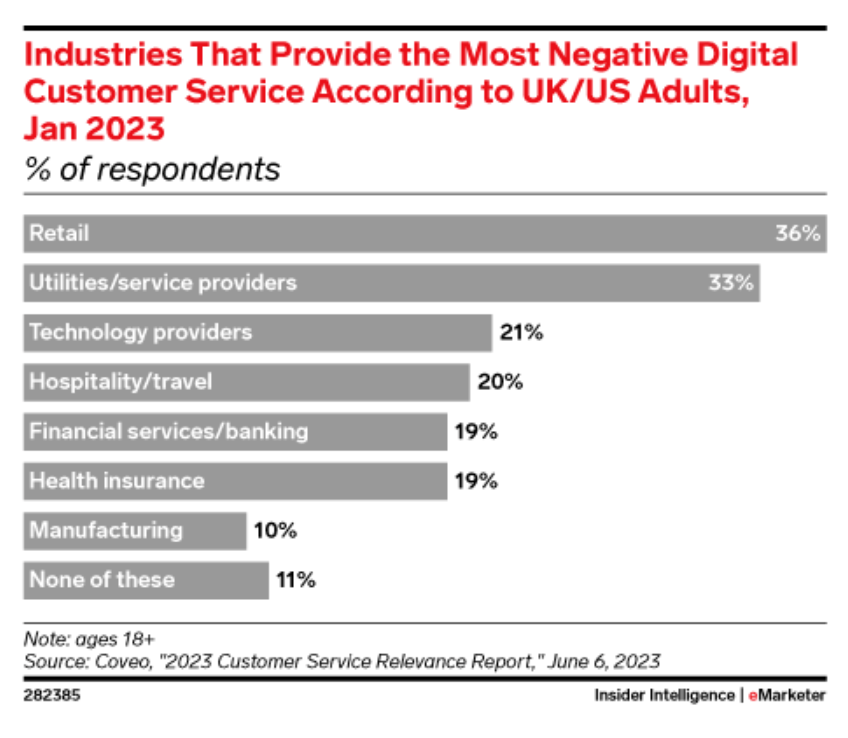 Just one in three (30%) said they were fully satisfied with the current customer care experience. Source: eMarketer
Just one in three (30%) said they were fully satisfied with the current customer care experience. Source: eMarketer
The good news is that just like a poor experience alienates the user, a great one delights them.
Great products attract customers, great experiences retain them. 42% of consumers stated that retailers and online brands offer better customer care today than they did pre-pandemic, according to a survey by Conduent. (I will rest all of my faith upon this survey, honestly, I can’t remember the world before the pandemic, feels like 39 years ago)
When surveyed, consumers stated they liked retailers that offer:
- Personalized service
- Email promotions
- Custom discount codes
- Tailored product recommendations
A high-quality, personalized experience is key for DTC brands to differentiate from giant marketplaces (…don’t say Amazon, don’t say Amazon, don’t say Amazon…) that are too big to offer that.
Probably nothing of what you’ve just read is new for you (1). The idea of building a positive customer experience is a truism, but it’s not an easy one. Here are 8 tips from a CX expert to make it easier.
(1) By no means the author is stating that you’ve just wasted 5 mins of your time reading this, that would be horrible CX from his part.
8 Tips to Improve Customer Experience
1. Talk to your CX team:
Unsung heroes in any organization. As Amanda defines them “CXers are the all-seeing eyes of any DTC company.” A team of people answering emails, replying to chats in real-time, holding the line. Those are the ones that know your customer best.
So, first insight: Go talk to your CX team.
Make sure to ask them questions like:
- What is going well? What isn’t?
- What issues are we seeing consistently over many weeks?
- What are you spending a lot of time on consistently? Can we automate it? Can we put it on the website?
- What is a task that you hate doing? How can we fix it? Important Note: ask THEM for the solution and work together to build it.
- What are the tasks you LIKE doing? Important Note II: double down on this. Lean into what makes people feel good at work. A happy employee can be 13% more productive(2).
If you just leave this article right now and go meet with your CX Team (buying them a coffee won’t hurt either) the lesson will be worth it.
(2) https://www.hp.com/us-en/shop/tech-takes/why-happy-employees-are-good-for-business
 Organize cross-functional team sessions to improve CX. Source: Voice-of-reason: using frontline insights for better CX.
Organize cross-functional team sessions to improve CX. Source: Voice-of-reason: using frontline insights for better CX.
Still here? Shame on you. After you finish this article, remember to talk to your CX team. please.
2. Ask questions before asking for money:
Ask questions to your store visitors. Try to understand who they are and why they are buying.
The internet landscape is navigating through strong user privacy shifts. (You probably have heard of Apple’s recent IDFA deprecation and Google’s imminent Privacy Sandbox) Long (and technical) – story short: third-party data from your users is getting harder and harder to get. This means you will have less and less information from your customers.
Thus, asking questions directly to your online visitors is a great way to get valuable first-party data.
As Jacquelyn de Jesu, founder of Shhhowercap advised: try to understand what makes users buy your product (Spoiler Alert: this will be covered in more depth in lesson #3).
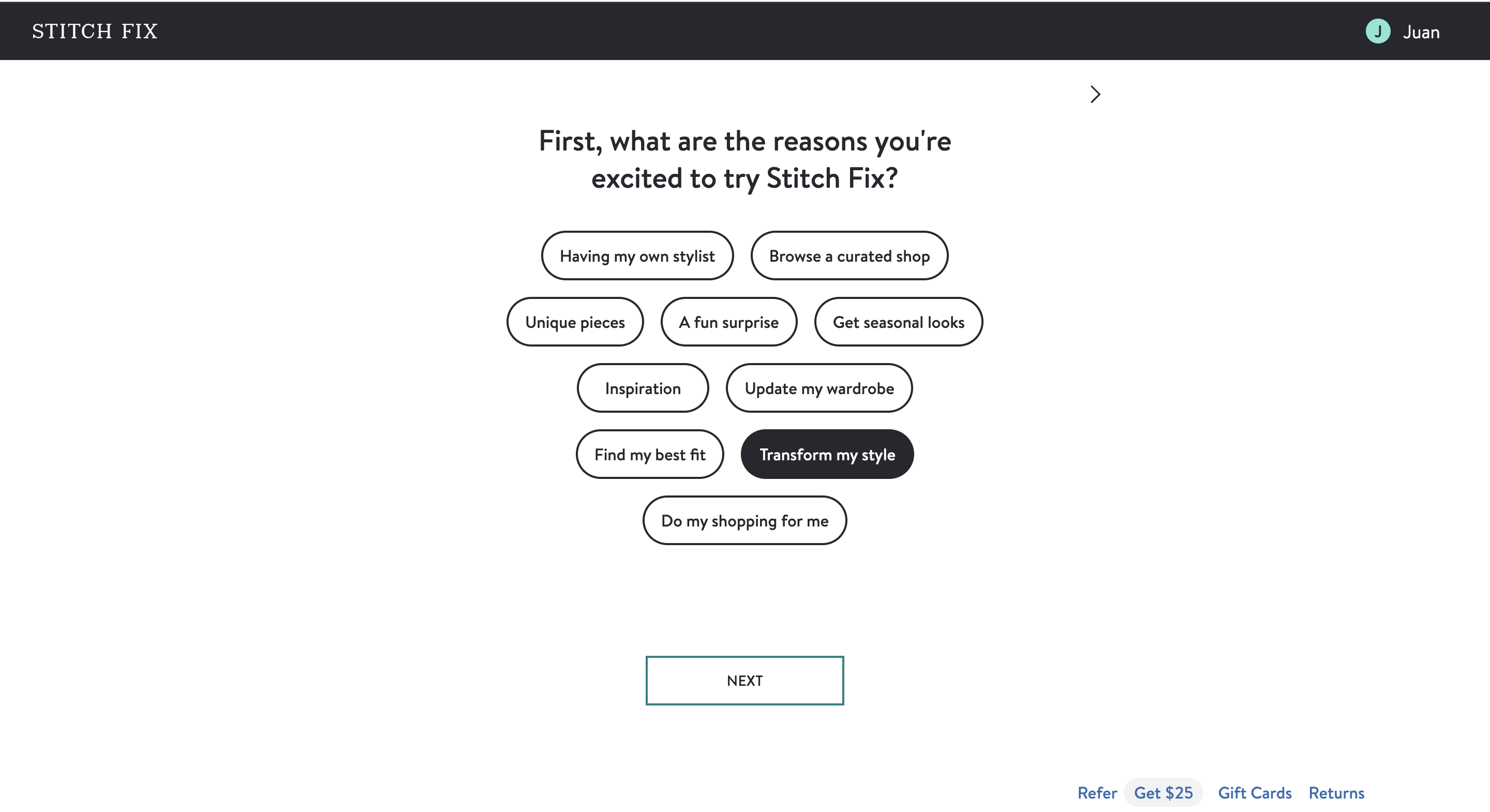 StitchFix uses an onboarding questionnaire to accurately personalize its outfit recommendations. (working for a Growth Transformation Company, my first answer was a no-brainer ;)
StitchFix uses an onboarding questionnaire to accurately personalize its outfit recommendations. (working for a Growth Transformation Company, my first answer was a no-brainer ;)
3. Educate your customers and your brand
Amanda states that asking questions (and answering them!) to the user is even more important for brand selling items with certain degrees of complexity. Her company, Love Wellness,
is a women’s wellness brand focused on safe and effective solutions for common issues across vaginal, gut, beauty, and total body/brain health. They are eliminating the stigma surrounding women’s health conversations.
I don’t believe I have what it takes to fit their Customer Persona. However, when I imagine myself buying their products, I recognize the need to do a fair amount of research on their website first.
Empower your users with information to make it easier for them to get your product.
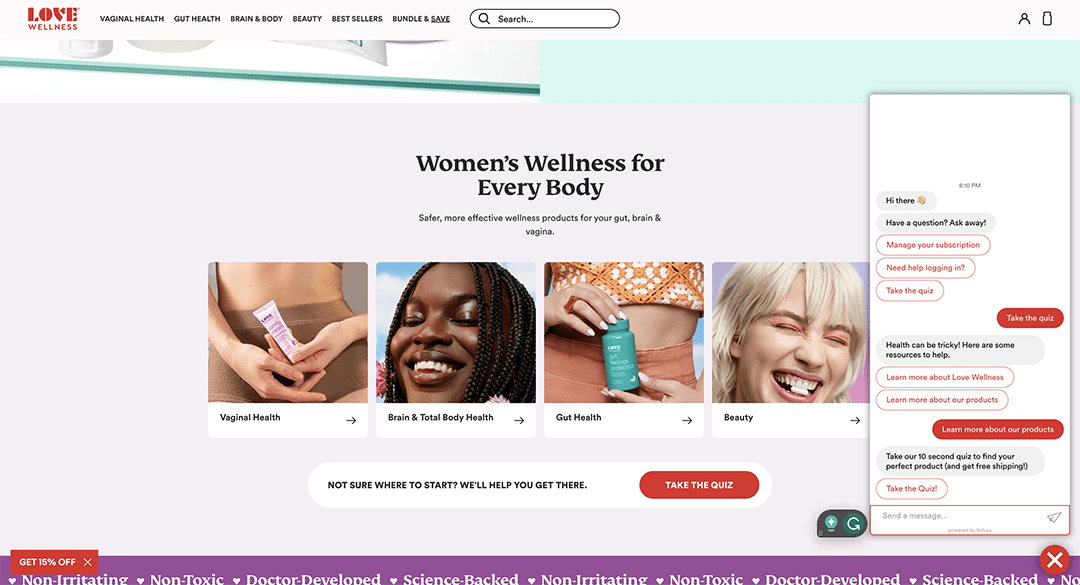 Love Wellness encourages users to take a Quiz to learn more about their products.
Love Wellness encourages users to take a Quiz to learn more about their products.
Using chatbots, polls or automated forms is a great way to educate your customers about your brand, and to educate your brand about your customers.
4. Ask fast, answer faster:
When in doubt or trouble, your customers need answers. Fast.
Great customer service can delight customers, even when the product hasn’t.
Love Wellness CX team north star metric is First Response Time. (FRT)
FRT is the time elapsed between a customer raising a ticket/question/email and an agent first responding to it(3). The industry’s standard FRT can range between 24-48 hours. Amanda’s team sets an ambitious goal of under 12 hours for 24 hours/7 days a week and under 2 hours during business hours.
However, do not be mistaken, being a fast respondent does not mean sacrificing quality over quantity.
When answering customer queries, Amanda advocates for her team to focus on providing well-researched responses. “Focus on quality first, and volume will follow”.
She shared some tips to answer customer questions faster:
- Automate repetitive tasks (spoiler: this is covered more deeply in Tip #5)
- Publish effective content on your website (i.e. knowledge that answers your customer questions)
- Streamline responses within your inbox to make replying easy, efficient and effective
- Be selective with your communication channels (e.g. if you don’t need phones, don’t have a phone line(4).) (Third and last spoiler of the day: discussed on tip #6)
(3) https://www.geckoboard.com/best-practice/kpi-examples/first-response-time/
(4) Customer Service phone lines are expensive to operate, both labor and platform wise.
5. Automate repetitive tasks
A great portion of your customers’ issues are repeated. Machines are great for repetitive tasks. Put them to work.
Amanda recommends automating any task that has a process that can’t be broken or strayed from. For example: If your customers can’t log in to your website, 99,9% of the time resetting a password will solve it. Automate an email response to those types of queries.
Or, if a customer has received an incorrect or damaged product, and you always need a photo to process the replacement, automate the first touch to ask for those kinds of things.
Just like many meetings could have been an email, many emails could have been a template.
It’s highly advisable to use a CX platform(5) to automate as much as possible (Gorgias, Zendesk, Hubspot are great for this). If you are already using one, talk to your Customer Success Manager and ask to do an audit of your account. Make sure you are making the best out of it (chances are you probably aren’t)
If you want a third-party unbiased opinion, Winclap Tech Services Solution helps DTC brands optimize their tech stack.
Automating, will lift the burden on your CX teams, and free time for them to add value in higher impact tasks.
(5) https://www.g2.com/categories/digital-customer-service-platforms#grid
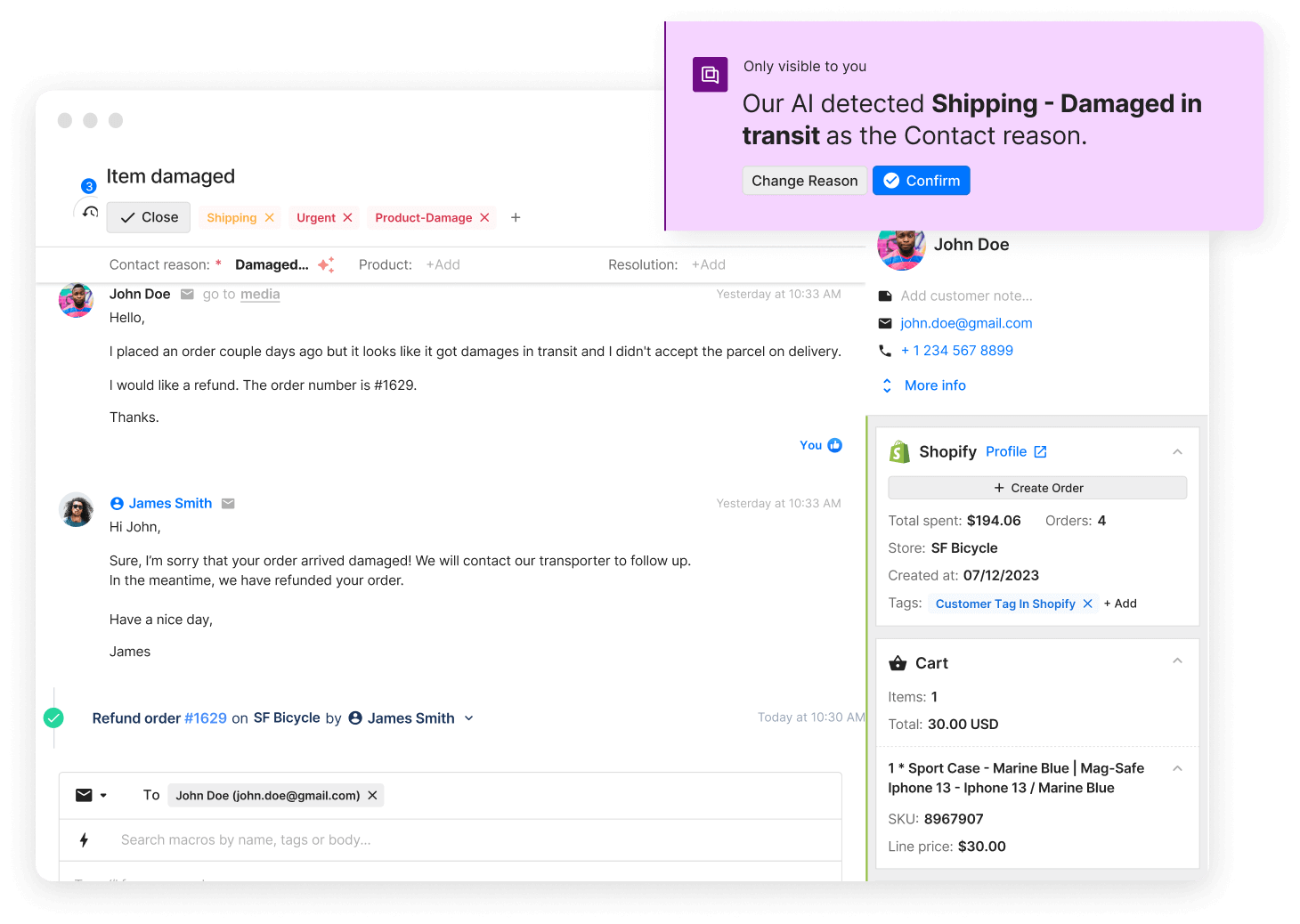 CS tools like Gorgias, use AI to automate repetitive time and make your CX team more efficient
CS tools like Gorgias, use AI to automate repetitive time and make your CX team more efficient
6. Omnichannel & Automation: cool but not always
Every brand wants to be Omnichannel, like Hansel on Zoolander, that’s so hot right now. It is recommendable to be available for your customers through several channels. However, Amanda warns us that not all channels work for all kinds of issues.
For example, on some occasions, your CX team will find it more convenient to send a long, more detailed reply via email, instead of via chat or SMS. Additionally, being able to automate longer canned responses via email macros allows for super quick and consistent communication with very little effort on their end.
Other times, customers will prefer to raise a concern via email to get hold of a human being rather than interacting with a not-so-smart-and-even-less-empathethic chatbot.
Although AI assistants are improving by the minute, they are still struggling to solve complex human requests. And those requests are where customers need your brand the most. Embrace these moments to generate empathetic connections with the other person behind the screen.
7. Be Transparent
Consumers have become experts at detecting brands’ bullsh*t. That’s why many successful brands are building strong trust among their customers by being transparent. That means, in many cases, being clear about what you know and what you don’t. And even asking for customers’ help in the latter cases. Amanda always recommends their team be genuine with their customers.
For Love Wellness, their efforts for transparency helped them understand what it meant to be a sustainable brand for their customers. After running customer surveys, they found out that users weren’t interested in their ideas for more sustainable packaging. Instead of going for reusable bottles, the company ended up developing larger bottles that needed to be ordered and delivered less often, as their customer suggested. The solution was not only a better outcome for the environment, but for the business as well.
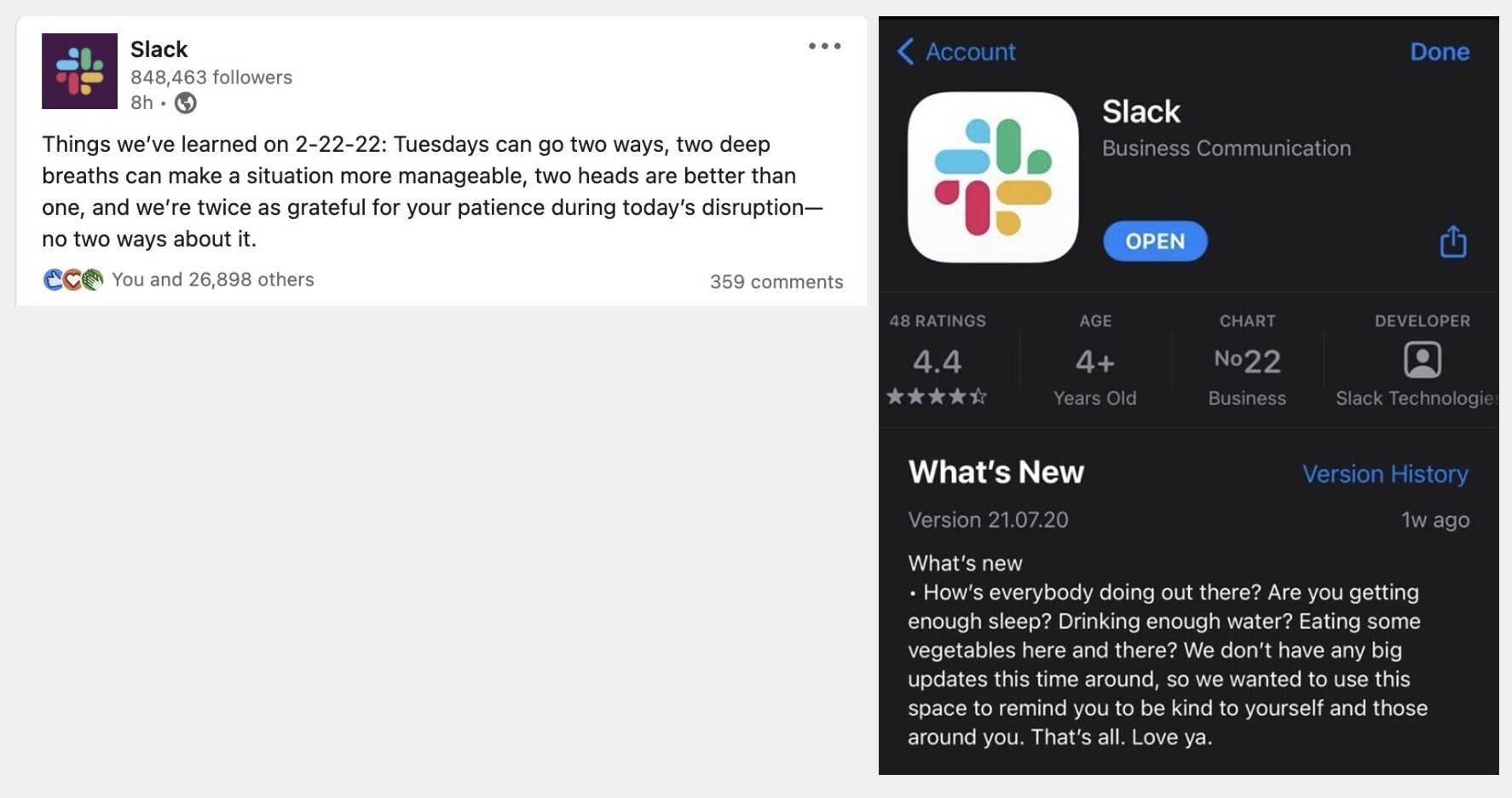 Slacks keeps an open and transparent communication stream with their customers, even when they have bad news to break or no information to share. Their transparent, down-to-earth tone has helped build a high level of empathy for the brand.
Slacks keeps an open and transparent communication stream with their customers, even when they have bad news to break or no information to share. Their transparent, down-to-earth tone has helped build a high level of empathy for the brand.
8. Do mandatory CX

If you have ever watched the movie The Intern (sorry, last movie reference, I promise), you’ll probably have noticed About The Fit’s CEO (portrayed by Anne Hathaway) doing customer service while running her company. Those things happen in real life too.
At Love Wellness, everybody in the company has to do mandatory CX. Moreover, companies like Disney, Southwest Airlines, and the Ritz-Carlton are famous for their Customer Service training which explains their strong CSAT scores.
For people who don’t play customer-facing roles, cross-functional CX training is probably the best opportunity to understand how users interact with a brand. It will help them connect issues with their daily task in their teams. Needless to say, meeting and interacting with other humans in the organization fosters valuable relationships between departments.
Summary
Building a great product will attract your customers. Building a great CX will help retain them.
- Talk to your CX team
- Ask questions before asking for money.
- Educate your customers and your brand
- Ask fast, answer faster
- Automate repetitive tasks
- Omnichannel & Automation: cool but not always
- Be transparent.
- Do mandatory CX
If you liked this article, I’m planning on sharing 2 other lessons from the recent DTCx Talk in NY. So my final question to you:
Will you like to receive the next DTCx Lesson?
Yes
About the authors:

VP of Customer Experience at LoveWellness.
Previously at Casper and Hulu she has been in CX for more than 10 years. When talking about being customer-centric, Amanda is at the epicentre.
Favorite movie is a tough one for her, but Forrest Gump is pretty high up there. Outside of movies, she spends a good chunk of time with her dog Pep, or cycling through NYC.

Thanks for reading
References:
https://content-na1.emarketer.com/customer-service-continues-pain-point-retailers
https://www.g2.com/categories/digital-customer-service-platforms
https://www.geckoboard.com/best-practice/kpi-examples/first-response-time/
https://slack.com/blog/transformation/a-modern-leaders-guide-to-organizational-transparency
https://www.spiceworks.com/tech/tech-general/news/slack-outage-service-disruption/
https://www.hp.com/us-en/shop/tech-takes/why-happy-employees-are-good-for-business
https://blog.hubspot.com/service/importance-customer-service#employees
https://blog.happyfox.com/10-best-companies-customer-service/#Apple

